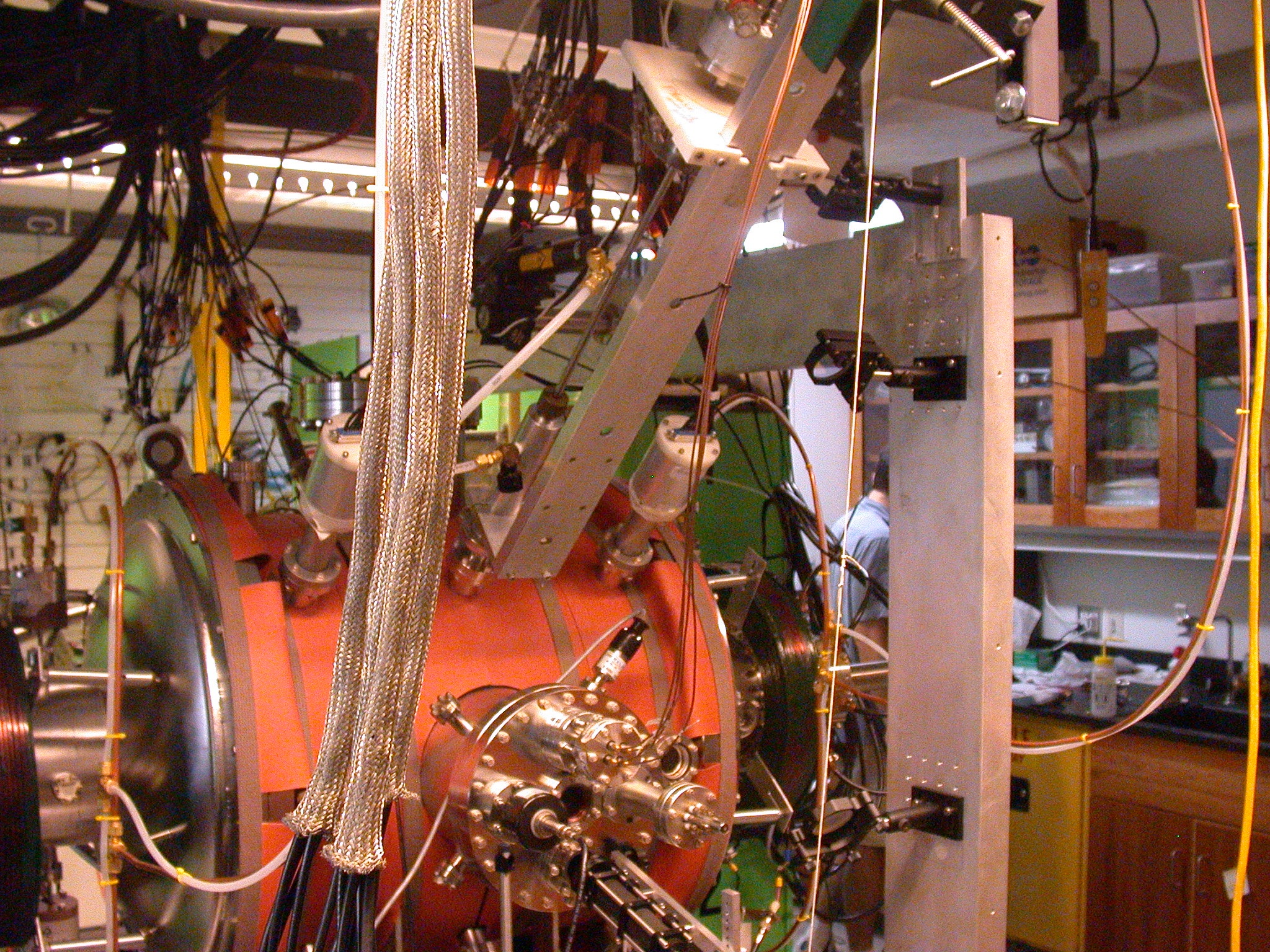The Swarthmore Magnetofluids Lab is located in room 116 of the Dupont
science building on Swarthmore's lovely
campus. The lab centers on the large vacuum vessel manufactured specially
for the lab in which we create spheromaks
and study their properties.
Above are the two sides of the gadget. In the back of the left picture
you can see a tall green structure (there is another off camera to
the left). It contains two capacitors each
of which is capable of storing a 10 kV charge and releasing it with an 100,000 A peak current. They store
a total of 25 kJ and can source that energy fast enough to produce about
a gigawatt of power. A pair of ignitrons act as high-speed, high-voltage switches. A bundle of coaxial
cables connect to the electrodes of the spheromak gun.
The stainless steel vacuum vessel is approximately one meter long with
numerous ports which allow access, especially along the midplane. The machine
is symmetric, with idential spheromak guns at the ends that are particaly visable.
The spheromaks are formed on each end simultaneously and are merged in
the center of the cynlindrical chamber. A bank of capacitors below the
chamber (blue) supply power to the 'stuffing flux' magnetic coils (the large
green and copper rings). They magnetize the coaxial plasma gun inside the endcap.
Hydrogen fed through the copper tubes is puffed in to the gun using a high-speed valve.
The cryogenic pump is the long shiny cynlinder immediately below the chamber visable in the right picture.
It pumps the chamber down to a preasure of 2e-7 torr, less than one billionth of an atmosphere -- a number
we constantly work to improve.
Please click on an image to see a larger version.
| Picture |
Description |
Used In |
 |
This is a blueprint of the vacuum vessel in one of its many configurations. Note the pair of spheromak guns connected to
large flux conservers. |
|
 |
This is what the chamber looked like when it was brand new. |
|
 |
The metal object is the 3D magnetic probe array, removed from the vacuum
chamber in this photo. The rods containing the probes are surrounded by
a Helmholtz coil used to calibrate the device. The Helmholtz coils,
which produce a known magnetic field, can be oriented in any of three
mutually perpendicular directions. Each rod measures the B
field at eight points along its length. The rods are arranged in a 5x5 grid. |
|
 |
Here, the 3D magnetic probe is sealed in place to the vacuum chamber. The
probe rods extend inside the orange cylinder to measure the magnetic
field in the small region where the spheromaks come into contact. In
this image, only five of the 25 data cables are attached to the device. |
|
 |
To interpret the three-dimensional data produced by the magnetic probe, we have created an IDL visualizer application. |
|
 |
This is the ion doppler spectrometer, which can measure the doppler shift in photons emitted from ions in the gadget. The blue fiber-optic cable links the SSX gadget to the sensor. The blue box houses the mirrors, while the black protrusion holds the photo multiplier tube (PMT), where all the wires are coming out. |
|
 |
An older mach probe -- the white boron nitride ceramic at the head of the probe has been turned black by long term use in the plasma. |
|
 |
Here the probe can be seen in SSX during helium cleaning. |
|
 |
This new larger mach probe is used for local flow measurements. |
|
 |
The insides of the new probe. Each wire attaches to a tungsten rod housed in the boron nitride. |
|
 |
This is the probe mounted on a piston so that it can be raised and lowered in to the gadget. |
|
 |
The probe assembly -- in top center of the picture -- mounted to the gadget. |
|
 |
This high-resolution magnetic probe is currently development -- it has not been tested yet. It consists of a quartz tube with 16 small coils inside and boron nitride end plugs. The tight spacing of the coils will give a resolution of 2.3mm. The probe will be placed at the midplane of the machine where reconnection occurs. |
|
 |
This 4-point Langmuir probe measures the plasma's temperature and density. The left end is inserted into the vacuum chamber. The bellows allows the probe to be moved radially in and out. |
|
 |
The vacuum UV spectrometer measures photon emission from impurities in the plasma. |
|
 |
This is a more recent picture of the VUV monochrometer. Here it is attached to the center of the main chamber. |
|
 |
This is disassembled soft x-ray detector (SXR). Partilces enter from the left and pass through the holes in the left most flange. Between the first and second flange are magnets that traps charged particles and prevents them from going further -- however photons pass through. There is a ceramic break, and then the photons enter one of the four photodiodes attached through the rightmost flange. Each photodiode has a different thin metal film over it, that filters out different frequencies of photons. |
|
 |
An older incarnation of SXR. |
|
 |
No Longer in Operation. The liquid sodium dynamo. The sphere of sodium is in the center, surrounded by a large Helmholtz coil. |
|